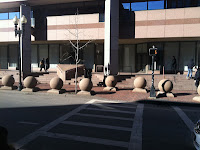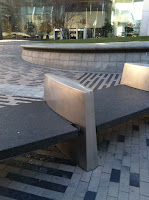Left: Ugly-as-sin bollards at the Tip O'Neill Building near North Station (probably added after construction). Right: Boring bollards at the newly-built Moakley Courthouse on Fan Pier.And they don't have to be ugly as sin.
Take, for example, the Boston Federal Reserve bank. Considering it is one of 12 banks in the country charged with distributing the nation's cash supply, you probably don't want people to be able to ram a car in to it. The modernist building is striking—it's by far the tallest Federal Reserve Bank branch in the country and one of the tallest buildings in the city of Boston—so it has quite a bit of symbolic value. For a variety of reasons, you don't want cars driving in willy-nilly. (If you do drive in, you go through a heated inspection building where they inspect your vehicle, including peering underneath with mirrors on sticks.)
Around the time of the Big Dig (check it out on HistoricAerials, or this picture from the installation firm) the plaza around the building was rebuilt, and instead of a bunch of concrete or aluminum-and-steel bollards, the landscape architects got creative. There are no fewer than 15 distinct types of bollard (!)—or other fencing with a similar function—combining different materials and serving multiple purposes. Many of these are cleverly camouflaged in to the landscape. You still get the idea that they don't want you trying to ram through the doors in a car, but it's not as ugly or overbearing as most such security.
I noticed this (yet again) coming back from a talk by Julie Campoli, who has cataloged housing types and walkability beautifully in presentations and books, and decided to do something similar with the Fed bollards. Here is a compendium, with descriptive names I made up.
Left: Steel-and-bench
Center: Single-indent concrete
Right: Double-indent concrete
Left: Slate-with-bench
Center: Wide steel
Right: Marble and stacked-slate
Left: Upside-down boat keel
Center: Square steel
Right: Big round planter
Left: Trapezoidal-ish steel
Center: Boat keel with bench
Right: Torpedo/candlepin bowling pins
Left: Beveled concrete with square holes
Center: Corners with benches
Right: Beveled concrete with extending benches
There would be a larger project here to walk (or bike) around the city and find all the different examples of anti-vehicle security. Maybe when it's above 20 degrees.
Walking around the Fed, you get the idea that someone put some thought in to the landscape. It is a large and looming building (it's tall and attractive, but it looms) but the plaza is built to a human scale without being monotonous and without losing its security purpose. There are a multitude of materials (granite, slate, concrete, aluminum, steel, brick, grass), shapes and sizes. Much of the plaza is functional. Benches provide a place to stop and sit. Trees provide shade. And it's unobtrusive (unlike the horrible Tip O'Neill balls o' concrete or the mid-sidewalk steel bollards down Atlantic Avenue at Rowes Wharf). Hopefully new buildings, when they need this type of security, will have some scrutiny as to how it is designed. This is a good example.
Now, there's the argument that this site sacrifices a lot of density by having this big plaza, and despite the height of the building its floor-area ration (FAR) is not that high, only about 4:1! (In other words, if there was a four story building built across the whole site (which is what this building replaced) it would be denser, despite the fact that this is the third tallest building in the city! But at least the security outside is pleasant.

















I'm local to Albany NY and have never seen the Tip O'Neil Building. I'm a professional artist so I could use a lot of artistic terminology and rules of balance, composition, harmony, etc. to detail why I like those bollards, but they just look nice to me. They are big and important and solid and that's part of the psychology of government administration buildings. But they are also human in scale. They don't block the view unless you're a tyke who would almost certainly be amused by them anyway. I'd like to sit on one and have a bite.
ReplyDeleteAgree to disagree, I guess. I find that they don't fit with the streetscape down low (really no bollards block views; they're all a few feet high), they are prone to getting moved about, the texture has nothing to do with the area nearby, or really the city in general, and they block a lot of movement on the sidewalk in an otherwise high-pedestrian area.
Deleteyour blog is very good thank you for share intrigue.lighting.
ReplyDelete